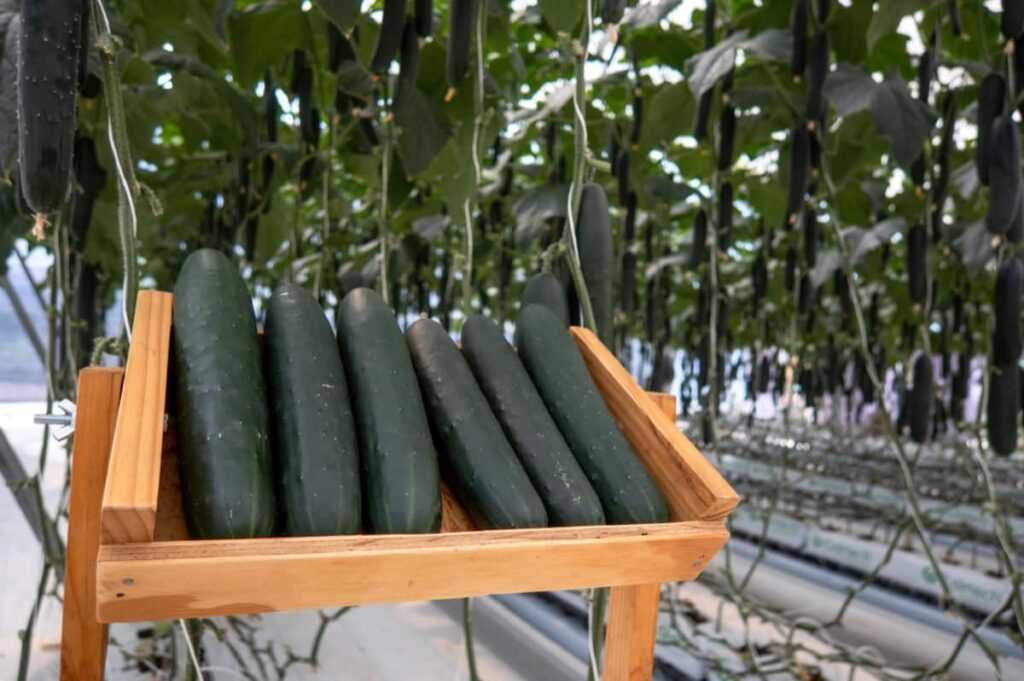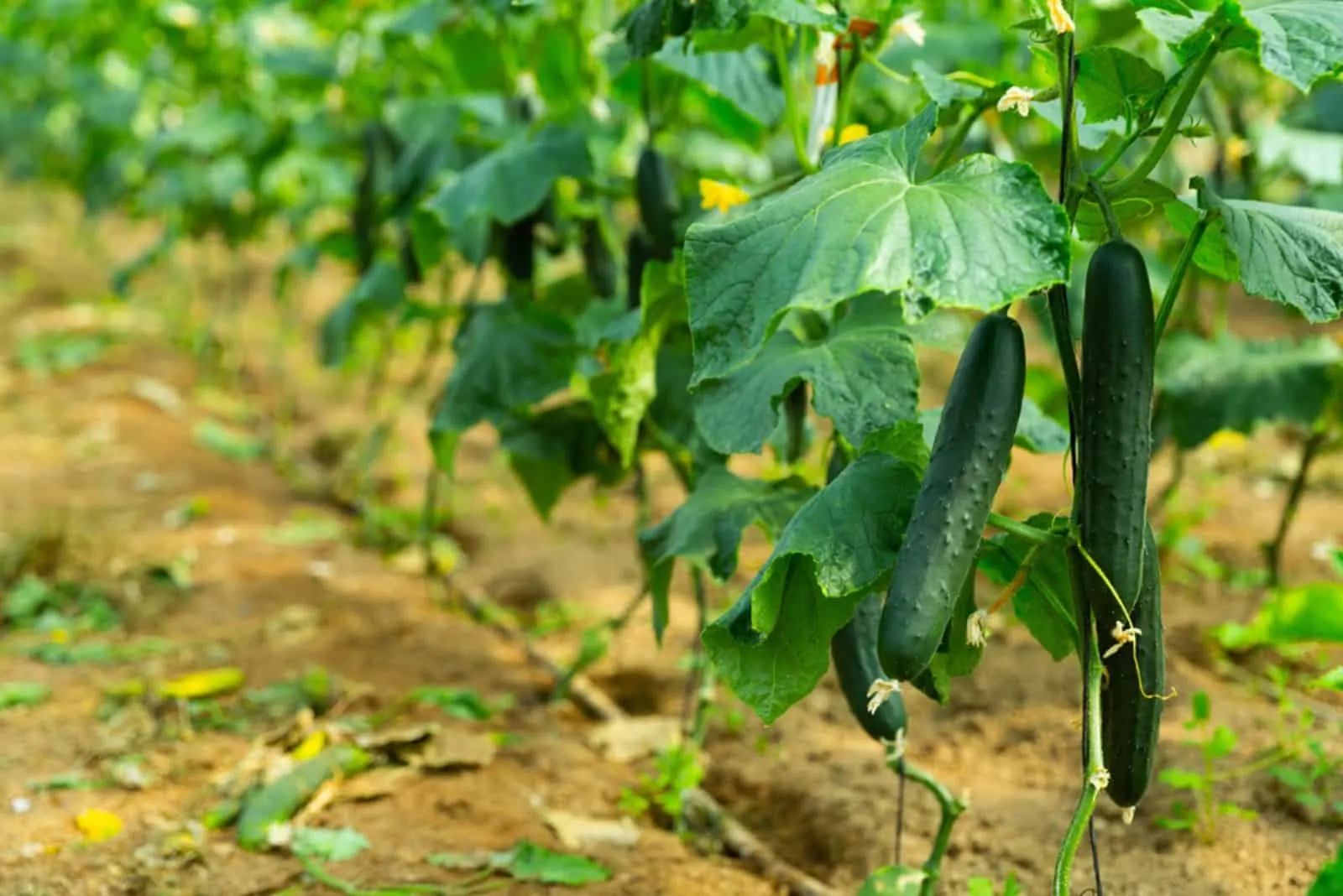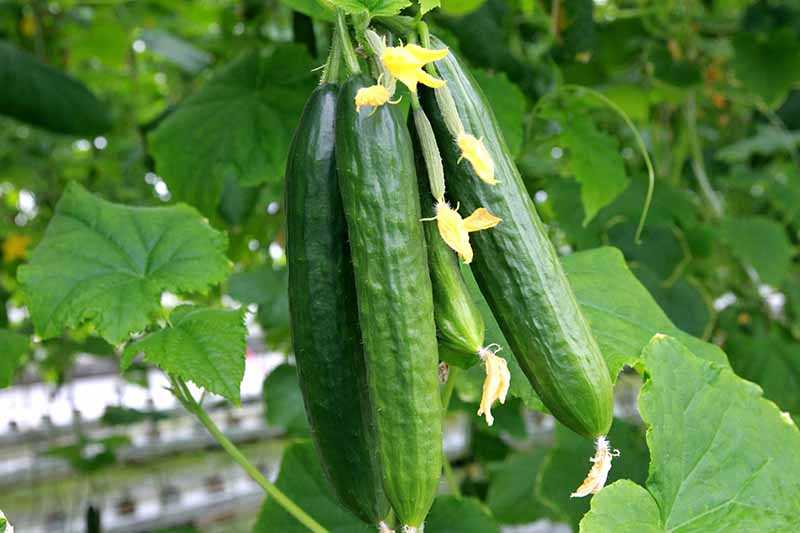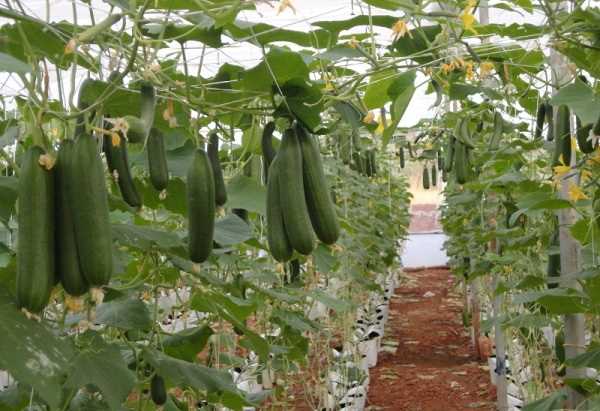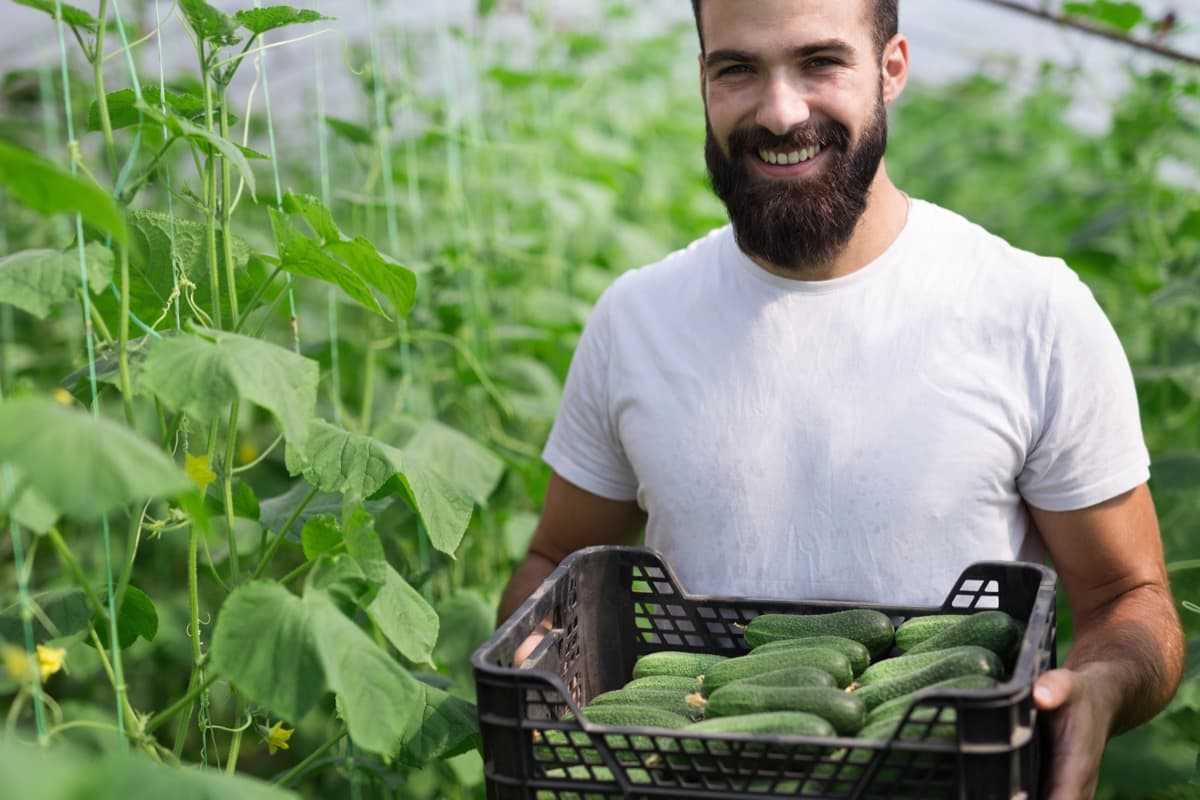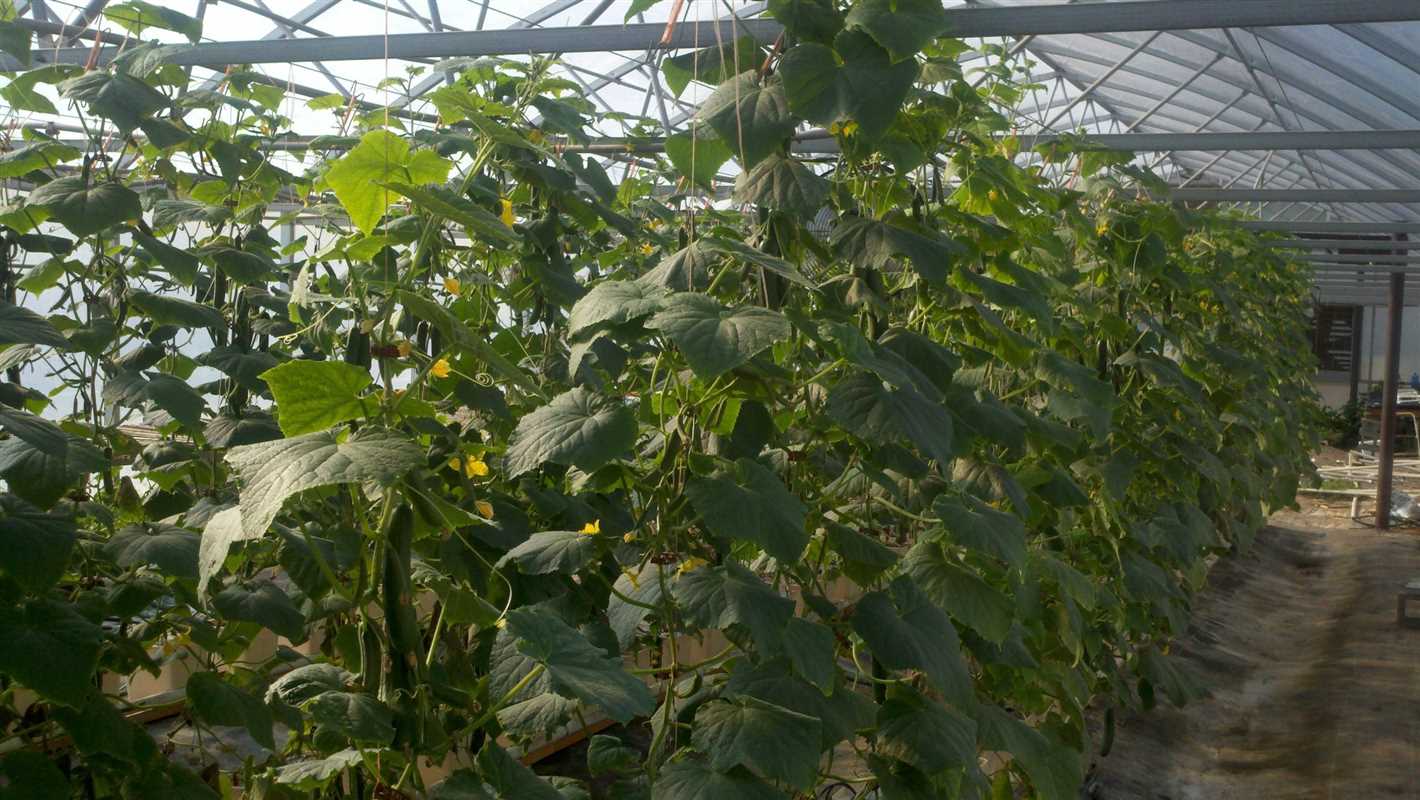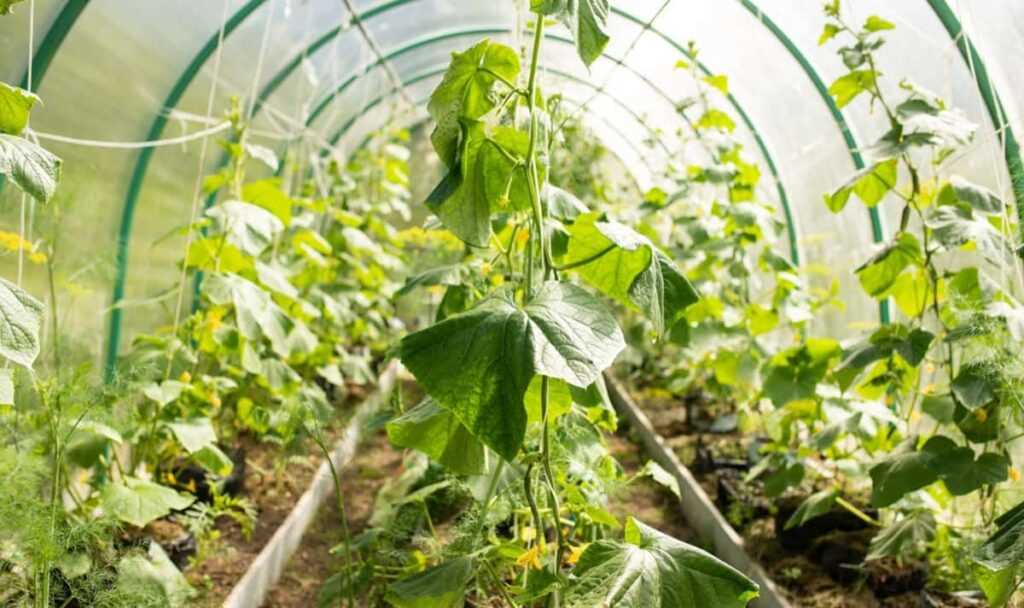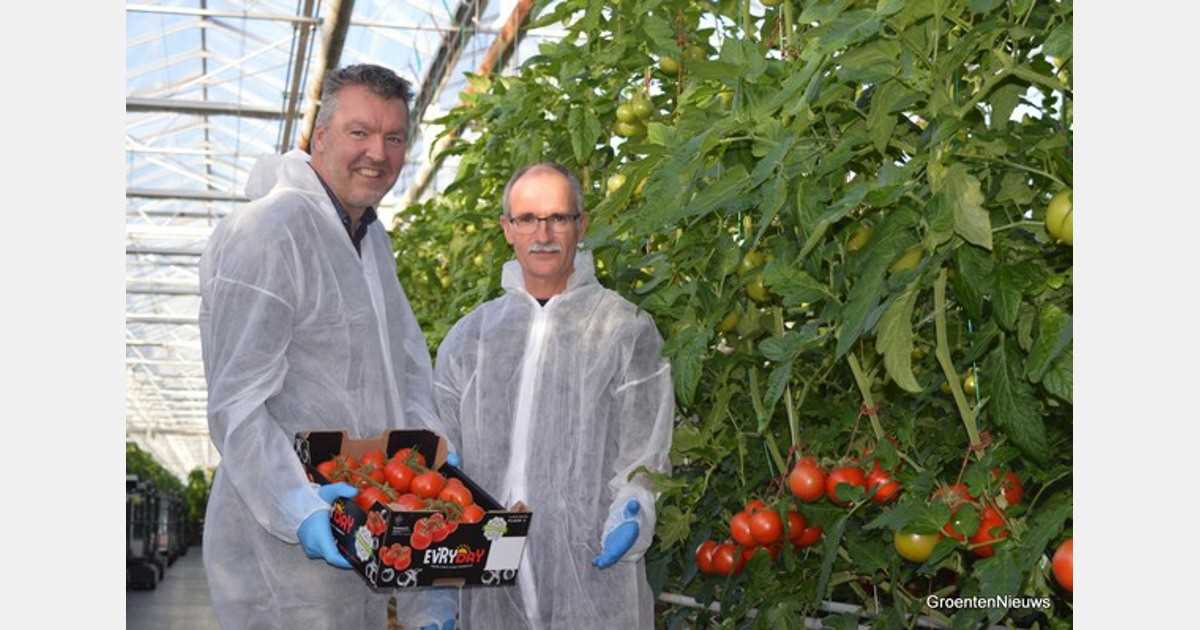- The Importance of Greenhouse Cultivation
- 1. Extended Growing Season
- 2. Protection from External Factors
- 3. Enhanced Crop Quality and Yield
- 4. Water Conservation
- 5. Pest and Disease Control
- Choosing the Right Cucumber Variety
- Growing Conditions
- Market Demand
- Personal Preferences
- Considerations for Autumn Cultivation
- Preparing the Greenhouse
- 1. Clearing and Cleaning
- 2. Disinfection
- 3. Installing Shading Nets
- 4. Setting up Irrigation System
- 5. Ventilation
- 6. Trellising System
- 7. Soil Preparation
- 8. Pest Prevention
- 9. Monitoring and Maintenance
- Optimal Conditions for Cucumber Growth
- Temperature
- Light
- Humidity
- Watering
- Nutrition
- Pests and Diseases
- Trellising
- Harvesting
- Planting and Maintaining Cucumber Seedlings
- Choosing the Right Seedlings
- Preparing the Soil
- Planting the Seedlings
- Providing Adequate Watering
- Maintaining Temperature and Humidity
- Supporting the Growing Plants
- Fertilizing the Seedlings
- Monitoring for Pests and Diseases
- Step-by-Step Guide to Planting
- 1. Choose a cucumber variety
- 2. Prepare the soil
- 3. Germinate the seeds
- 4. Transplant seedlings
- 5. Provide support
- 6. Water and fertilize
- 7. Monitor and control pests
- 8. Harvesting
- 9. Rotate crops
- 10. Clean and maintain the greenhouse
- Best Practices for Watering and Fertilizing
- Tips for Healthy Cucumber Growth
- Protecting Cucumber Plants from Pests and Diseases
- “Question-Answer”
- What are the benefits of cultivating cucumbers in a greenhouse during autumn?
- What are the key factors to consider when cultivating cucumbers in a greenhouse during autumn?
- What are some common challenges faced when cultivating cucumbers in a greenhouse during autumn?
- What are some recommended cucumber varieties for autumn greenhouse cultivation?
- How often should cucumbers be watered in a greenhouse during autumn?
- Are there any specific pest control measures that should be taken when cultivating cucumbers in a greenhouse during autumn?
- What are the potential yields of cucumbers in a greenhouse during autumn?
- “Video” HOW TO PRUNE CUCUMBER PLANTS FOR BEST PRODUCTIONS
Autumn greenhouse cucumber cultivation has become an increasingly popular choice for many growers due to its numerous benefits. With proper planning and care, cultivating cucumbers during autumn in a greenhouse environment can lead to a clear example of success. This article will explore the advantages of this cultivation method and provide valuable insights for growers looking to achieve fruitful results.
One of the main advantages of autumn greenhouse cucumber cultivation is the ability to control the growing environment. Greenhouses provide an ideal setting for cucumbers as growers can regulate temperature, humidity, and light conditions to optimize plant growth. This level of control allows for the extension of the growing season, enabling growers to produce cucumbers when they are in high demand and command higher market prices.
In addition to environmental control, greenhouse cultivation offers protection against unpredictable weather conditions during the autumn months. Cucumbers are susceptible to cold temperatures and frost, which can significantly impact plant health and yield. By growing cucumbers in a greenhouse, growers can safeguard their crop from these adverse conditions and ensure a stable and consistent supply of high-quality cucumbers throughout the autumn.
Furthermore, autumn greenhouse cucumber cultivation minimizes the risk of pests and diseases. Greenhouse structures act as a physical barrier, preventing insects and other harmful organisms from reaching the crop. In addition, by maintaining a clean and controlled growing environment, growers can reduce the occurrence of diseases that often thrive in outdoor conditions. This results in healthier plants and higher yields, establishing a clear example of success for growers.
The Importance of Greenhouse Cultivation
Greenhouse cultivation plays a vital role in modern agriculture. It combines the benefits of indoor cultivation with the advantages of outdoor farming, allowing farmers to control various environmental factors to optimize plant growth and productivity. Here are some reasons why greenhouse cultivation is important:
1. Extended Growing Season
Greenhouses provide a controlled environment, allowing farmers to extend the growing season and cultivate crops year-round. This is especially valuable in regions with short summers or harsh winters. With greenhouses, farmers can grow crops that are otherwise not well-suited for the local climate or can produce high-quality crops even during winter months.
2. Protection from External Factors
Greenhouses offer protection from extreme weather conditions, pests, and diseases. They act as a barrier to keep out harmful elements such as heavy rains, hailstorms, strong winds, and excessive heat or cold. This protection creates a stable and favorable environment for the plants, reducing the risk of damage and crop loss.
3. Enhanced Crop Quality and Yield
The ability to control environmental factors such as temperature, humidity, and light intensity in greenhouses enables farmers to optimize plant growth and maximize crop quality and yield. By carefully adjusting these factors, farmers can create the ideal conditions for each specific crop, resulting in healthier and more productive plants.
4. Water Conservation
Greenhouses allow for efficient water use, as they minimize evaporation and runoff. The controlled environment inside the greenhouse reduces water loss through evaporation, while proper irrigation systems ensure that the plants receive the necessary amount of water with minimal waste. This contributes to water conservation, a critical factor in sustainable agriculture.
5. Pest and Disease Control
Greenhouse cultivation provides a physical barrier that prevents pests and diseases from infesting the crops. By restricting the entry of insects, birds, and other animals, farmers can significantly reduce the risk of crop damage and the need for chemical pesticides. This promotes healthier crops and reduces the environmental impact associated with pesticide use.
Summary of the Importance of Greenhouse Cultivation Benefits Description Extended Growing Season Allows year-round cultivation and the growth of crops in unfavorable climates Protection from External Factors Shields crops from extreme weather conditions, pests, and diseases Enhanced Crop Quality and Yield Optimizes plant growth through control of environmental factors, resulting in healthier and more productive plants Water Conservation Minimizes water loss through evaporation and ensures efficient use of water Pest and Disease Control Prevents infestation, reducing the need for chemical pesticides and promoting healthier crops Choosing the Right Cucumber Variety
When it comes to cultivating cucumbers in your autumn greenhouse, one of the most important decisions you will make is selecting the right cucumber variety. The choice of cucumber variety depends on several factors, including your growing conditions, market demand, and personal preferences. Here are some key factors to consider:
Growing Conditions
- Temperature: Some cucumber varieties are more tolerant of cooler temperatures, while others thrive in warmer conditions. Consider the average temperature in your greenhouse during the autumn season and choose a variety that is suitable for those conditions.
- Light: Cucumbers require ample sunlight to grow and produce fruit. If your greenhouse has limited natural light, consider selecting a variety that is known for its tolerance to low light conditions.
- Space: Take into account the available space in your greenhouse. Some cucumber varieties are more compact and can be grown in smaller areas, while others require more room to spread and may not be suitable for tight spaces.
Market Demand
It’s important to consider the market demand for cucumbers in your area. Research which cucumber varieties are popular and in high demand among consumers and local markets. Choosing a variety that is in demand can increase your chances of success and profitability.
Personal Preferences
- Taste: Different cucumber varieties have varying flavors and textures. Consider your personal preferences and choose a variety that matches your taste preferences.
- Appearance: Cucumbers come in different shapes, sizes, and colors. Some varieties are known for their unique appearance, which may be a selling point for certain markets or consumers. Consider the appearance of the cucumber variety and whether it aligns with your target market.
- Intended Use: Certain cucumber varieties are better suited for slicing, pickling, or salads. Consider how you plan to use the cucumbers and choose a variety that is best suited for your intended use.
By taking into consideration the growing conditions, market demand, and personal preferences, you can make an informed decision when choosing the right cucumber variety for your autumn greenhouse cultivation. Remember to also research and consult with local experts or agricultural extension offices for specific recommendations based on your location.
Considerations for Autumn Cultivation
1. Temperature Control:
Autumn is a season marked by fluctuating temperatures, so it is important to maintain proper temperature control in the greenhouse to ensure optimal cucumber growth. Consider using a thermostat-controlled ventilation system to regulate the temperature and prevent extreme fluctuations.
2. Light Requirements:
Cucumbers require adequate sunlight to grow and develop properly. As days become shorter in autumn, it is important to provide supplemental lighting to ensure that the plants receive the necessary amount of light. Consider installing grow lights or using reflective surfaces to optimize light distribution within the greenhouse.
3. Watering:
Proper watering is crucial for successful autumn cucumber cultivation. As the temperature starts to cool down, the plants will require less water compared to the growing season. Monitor the soil moisture levels closely and adjust the watering frequency accordingly. Avoid overwatering, as it can lead to root rot or other fungal diseases.
4. Nutrient Management:
Provide the plants with sufficient nutrients to promote healthy growth. Conduct soil tests to determine any nutrient deficiencies and adjust the fertilizer accordingly. Remember that the nutrient requirements may vary throughout the growing season, so monitor the plants regularly and make necessary adjustments to the fertilization schedule.
5. Pest and Disease Control:
Pests and diseases can still be a threat in the autumn greenhouse. Implement preventive measures, such as regular monitoring and application of organic or chemical pest control methods. Remove any diseased plants promptly to prevent the spread of diseases.
6. Crop Rotation:
Consider rotating the cucumber crop to prevent the buildup of pests and diseases in the greenhouse. This practice helps to maintain the overall health of the plants and minimize the risk of recurrent issues. Plan your crop rotation cycle in advance to ensure a smooth transition between seasons.
7. Harvesting:
Monitor the cucumber plants closely for ripeness and harvest them promptly when they are ready. Be mindful of the decreasing daylight and temperature, which can slow down the ripening process. Regularly check for mature cucumbers to prevent over-ripening or deterioration.
8. Maintenance and Cleanliness:
Regular maintenance and cleanliness are essential for a successful autumn cucumber cultivation. Remove any fallen leaves, debris, or dead plant material from the greenhouse to prevent the accumulation of pathogens. Clean and disinfect the greenhouse equipment regularly to minimize the risk of disease transmission.
By considering these factors, you can enhance the chances of a fruitful autumn cucumber cultivation in your greenhouse. Remember to adapt your cultivation practices based on the specific needs of your cucumber variety and the local climate conditions.
Preparing the Greenhouse
1. Clearing and Cleaning
Before starting the cultivation of greenhouse cucumbers, it is important to clear and clean the greenhouse thoroughly. This will help to remove any weeds, debris, and pests that may impede the growth of the cucumbers.
2. Disinfection
After clearing the greenhouse, it is necessary to disinfect the entire structure to eliminate any harmful bacteria or fungi that may be present. This can be done using disinfectants specifically designed for greenhouse cleaning.
3. Installing Shading Nets
During the autumn season, the intensity of sunlight may become too strong for cucumber plants. To protect them from excessive heat and prevent sunburn, installing shading nets is crucial. These nets will help in maintaining optimal temperature and light levels.
4. Setting up Irrigation System
A well-designed and efficient irrigation system is essential for successful cucumber cultivation. Ensure that the greenhouse has a drip irrigation system installed, as it provides a uniform water supply directly to the roots while minimizing water wastage.
5. Ventilation
Proper ventilation is necessary for maintaining the right humidity and temperature levels inside the greenhouse. Install ventilation devices such as fans or vents to ensure good air circulation and prevent the buildup of excess moisture.
6. Trellising System
Cucumber plants require support to grow vertically and stay off the ground. Installing a trellising system, such as strings or wire mesh, will help the plants climb and promote better air circulation around the foliage, reducing the risk of diseases.
7. Soil Preparation
Before planting cucumber seeds or seedlings, prepare the soil by adding organic matter and adjusting the pH levels if necessary. Cucumber plants thrive in well-drained and fertile soil, so ensure optimum conditions for their growth.
8. Pest Prevention
To prevent pests from damaging the cucumber plants, it is important to take necessary precautions. Set up insect traps, apply organic insecticides, and maintain proper hygiene within the greenhouse to minimize the risk of infestations.
9. Monitoring and Maintenance
Regular monitoring of the greenhouse environment and cucumber plants is essential to ensure optimum growth. Keep an eye on the temperature, humidity, and water levels, and maintain a regular schedule for pruning, fertilizing, and disease control.
By following these steps and providing the appropriate care, your autumn greenhouse cucumber cultivation can be set up for success!
Optimal Conditions for Cucumber Growth
For successful cucumber cultivation in an autumn greenhouse, it is essential to provide optimal conditions for the plants to thrive. Creating an environment that meets the specific needs of cucumber plants will result in healthy growth and high yields. Here are the key factors to consider:
Temperature
Cucumber plants require warm temperatures to grow properly. The optimal temperature range for cucumber growth is between 70°F (21°C) and 80°F (27°C) during the day and around 60°F (15°C) at night. It is important to maintain a consistent temperature within this range to promote plant growth and discourage stress from temperature fluctuations.
Light
Proper lighting is crucial for the photosynthesis process and overall plant development. Cucumber plants require abundant sunlight or the equivalent intensity of artificial light for a minimum of 10 to 12 hours per day. If natural light is insufficient, the use of supplemental lighting can help ensure optimal growth. A combination of cool white and warm white fluorescent lights is suitable for cucumber plants in a greenhouse setting.
Humidity
Cucumber plants thrive in relatively high humidity levels. The ideal humidity range for cucumber cultivation is between 80% and 90%. To maintain proper humidity levels, regularly mist the plants with water and use humidifiers if necessary. Adequate humidity promotes healthy leaf development and helps prevent issues like powdery mildew.
Watering
Consistent, regular watering is essential for cucumber plants. These plants require a well-draining soil mix to prevent waterlogged conditions. It is recommended to water cucumber plants thoroughly once or twice a week, making sure the soil is evenly moist. Avoid over-watering, as it can lead to root rot and other problems.
Nutrition
Cucumber plants require sufficient nutrients to develop properly. It is important to provide the plants with a balanced fertilizer rich in nitrogen, phosphorus, and potassium. Apply the fertilizer according to the instructions on the package and monitor the plants for any signs of nutrient deficiencies.
Pests and Diseases
Cucumber plants can be susceptible to various pests and diseases, such as aphids, spider mites, powdery mildew, and cucumber beetles. Regularly inspect the plants for any signs of infestation or disease and take appropriate measures to control them, such as using organic pesticides or natural predators.
Trellising
Trellising cucumber plants can help promote proper growth and conserve space in the greenhouse. By training the plants to grow vertically, you can provide better air circulation, increased light exposure, and easier fruit harvesting. Secure the plants with trellis netting or stakes to support their growth.
Harvesting
Cucumbers are ready for harvest when they reach the desired size, usually around 6 to 8 inches in length. Regularly check the plants for ripe cucumbers and harvest them promptly to encourage continuous fruit production. Use a sharp knife or pruning shears to cut the cucumbers from the plant, avoiding any damage to the vines or remaining fruits.
By providing optimal conditions and attentive care, you can cultivate healthy and productive cucumber plants in your autumn greenhouse. Following these guidelines will help you achieve a successful cucumber harvest.
Planting and Maintaining Cucumber Seedlings
Planting and maintaining cucumber seedlings requires careful attention to ensure healthy growth and a bountiful harvest. Here are some important steps to follow:
Choosing the Right Seedlings
When selecting cucumber seedlings, choose those that have a strong, healthy appearance. Look for dark green leaves and avoid those with yellowing or wilting foliage. It is also important to choose seedlings that are disease-resistant, as this will help to prevent any potential issues later on.
Preparing the Soil
Cucumbers thrive in well-draining soil that is rich in organic matter. Before planting the seedlings, prepare the soil by removing any weeds and adding compost or well-rotted manure. This will provide the seedlings with the necessary nutrients for vigorous growth.
Planting the Seedlings
Plant cucumber seedlings in rows, with a spacing of about 24-36 inches between each plant. Dig holes that are slightly larger than the seedling’s root ball and place the seedlings into the holes. Gently firm the soil around the base of the seedlings to provide support.
Providing Adequate Watering
Cucumber seedlings require consistent watering to promote healthy growth. Water the seedlings deeply, ensuring that the soil remains moist but not waterlogged. It is important to avoid overhead watering, as this can lead to fungal diseases. Instead, use a drip irrigation system or water the soil directly at the base of the plants.
Maintaining Temperature and Humidity
Cucumbers are warm-season crops, so they require specific temperature and humidity conditions to thrive. Maintain a temperature range of 70-85°F (21-29°C) during the day and around 60-70°F (15-21°C) at night. Additionally, provide adequate ventilation to prevent high humidity levels, as this can lead to the development of fungal diseases.
Supporting the Growing Plants
As cucumber plants grow, they will need support to prevent them from sprawling on the ground. Use trellises or stakes to support the plants, allowing them to grow vertically. This not only saves space but also helps to improve air circulation around the plants, reducing the risk of diseases.
Fertilizing the Seedlings
Regular fertilization is important for cucumber seedlings to ensure healthy growth and fruit production. Apply a balanced, water-soluble fertilizer according to the instructions provided. Avoid over-fertilizing, as this can lead to excessive foliage growth at the expense of fruit development.
Monitoring for Pests and Diseases
Regularly inspect cucumber seedlings for any signs of pests or diseases. Common pests include aphids, cucumber beetles, and spider mites. Treat any infestations promptly using organic or chemical insecticides, according to your preferences. Additionally, prevent diseases by providing good air circulation, avoiding overcrowding, and removing any infected plant material immediately.
By following these guidelines for planting and maintaining cucumber seedlings, you can ensure a successful harvest of delicious cucumbers from your autumn greenhouse!
Step-by-Step Guide to Planting
1. Choose a cucumber variety
Before planting, it’s important to choose a cucumber variety that is suitable for autumn greenhouse cultivation. Look for varieties that are resistant to diseases and thrive well in controlled environments.
2. Prepare the soil
Prepare the soil in the greenhouse by removing any weeds or debris. The soil should be well-drained and rich in organic matter. Use compost or well-rotted manure to improve the soil fertility.
3. Germinate the seeds
Start cucumber seeds indoors about 4-6 weeks before the last frost date. Plant 2-3 seeds per pot in a seedling tray filled with seed starting mix. Keep the soil moist and maintain a temperature of around 70°F for germination.
4. Transplant seedlings
Once the seedlings have developed 2-3 true leaves, they are ready to be transplanted into the greenhouse. Dig holes in the prepared soil, spacing them 18-24 inches apart. Gently remove the seedlings from the pots and place them in the holes, making sure to cover the roots completely with soil.
5. Provide support
Cucumbers are climbing plants and require support to grow vertically. Install trellises or stakes in the greenhouse to provide support for the cucumber vines. This helps to maximize growing space and keep the plants off the ground, reducing the risk of disease.
6. Water and fertilize
Water the cucumber plants regularly, keeping the soil consistently moist but not waterlogged. Avoid overhead watering to prevent the spread of diseases. Fertilize the plants every 2-3 weeks with a balanced fertilizer to provide them with essential nutrients.
7. Monitor and control pests
Monitor the greenhouse for any signs of pests such as aphids, whiteflies, or cucumber beetles. Use natural methods like introducing beneficial insects or organic pesticides to control pest populations and prevent damage to the plants.
8. Harvesting
Cucumbers are ready to be harvested when they reach the desired size. Check the variety’s maturity time for guidance on when to start harvesting. Use a sharp knife or scissors to cut the cucumbers from the vine, taking care not to damage the plant.
9. Rotate crops
To prevent the buildup of diseases and pests, rotate cucumber crops with other vegetables in the greenhouse. This helps to maintain the overall health of the soil and reduce the risk of recurring problems.
10. Clean and maintain the greenhouse
After harvesting, clean and disinfect the greenhouse to remove any lingering pests or diseases. This will help to prepare the greenhouse for the next planting cycle and ensure the best conditions for future crops.
Best Practices for Watering and Fertilizing
- Watering: Proper watering is crucial for the success of greenhouse cucumber cultivation during autumn. Here are some best practices:
- Monitor the moisture level in the soil regularly. Cucumbers prefer consistently moist soil, so avoid letting it completely dry out.
- Water the plants deeply and thoroughly, ensuring that the water reaches the plant’s roots.
- Avoid overhead watering, as it can promote the development of fungal diseases. Instead, use a drip irrigation system or water directly at the base of the plants.
- Water in the morning or early afternoon to allow the leaves to dry before evening, reducing the risk of disease.
- Adjust the watering frequency and amount based on the weather conditions. Cucumbers may require more water during hot and dry periods.
- Fertilizing: Providing the right nutrients is essential for healthy cucumber plants. Follow these best practices for fertilizing:
- Perform a soil test to determine the nutrient levels in the greenhouse. This will help you determine the appropriate fertilizers to use.
- Choose a balanced fertilizer with equal amounts of nitrogen, phosphorus, and potassium.
- Apply a slow-release fertilizer at the beginning of the growing season to provide a consistent supply of nutrients over time.
- Supplement with liquid fertilizers during the active growing period to boost plant growth and fruit production. Follow the manufacturer’s instructions for application rates.
- Avoid over-fertilizing, as it can lead to nutrient imbalances and damage to the plants. Regularly monitor the condition of the plants and adjust the fertilization schedule accordingly.
Tips for Healthy Cucumber Growth
- Choose the right cucumber variety: Select a cucumber variety that is suitable for greenhouse cultivation and has a good resistance to diseases and pests.
- Start with healthy seedlings: Ensure that the seedlings you use are strong and disease-free. This will help ensure healthy growth and minimize the risk of issues later on.
- Provide optimal growing conditions: Cucumbers thrive in warm and humid conditions, so maintain a temperature of around 75-85°F (24-29°C) and a humidity level of 60-70%. Use a humidifier or mist the plants regularly to maintain the required humidity.
- Provide ample sunlight: Cucumbers require at least 8 hours of direct sunlight each day. Place the plants near a south-facing window or use artificial grow lights to supplement the natural light.
- Water consistently: Cucumbers need regular watering to prevent the soil from drying out. Water the plants thoroughly, keeping the soil evenly moist but not waterlogged.
- Prune the plants: Regularly prune the cucumber plants to remove any dead or damaged leaves, as well as any side shoots that may hinder airflow and promote disease.
- Provide support: Cucumbers are vine plants and benefit from vertical support. Use trellises or stakes to help the plants grow upward, reducing the risk of diseases and providing ease of harvest.
- Monitor for pests and diseases: Regularly inspect the plants for signs of pests or diseases. Can monitor for common cucumber pests like aphids, cucumber beetles, and spider mites. Additionally, keep an eye out for diseases such as powdery mildew and bacterial wilt.
- Fertilize appropriately: Cucumbers are heavy feeders and benefit from regular fertilization. Use a balanced fertilizer or organic compost to provide the necessary nutrients for healthy growth.
- Harvest at the right time: Cucumbers are ready for harvest when they reach the desired size and color. Be sure to regularly harvest the cucumbers to encourage further production.
Follow these tips for healthy cucumber growth, and you’ll be rewarded with a bountiful harvest of delicious and fresh cucumbers from your autumn greenhouse cultivation!
Protecting Cucumber Plants from Pests and Diseases
Growing cucumbers in a greenhouse can provide a controlled environment that helps to protect the plants from many pests and diseases. However, it is still important to take preventative measures to ensure the health and productivity of your cucumber plants. Here are some tips for protecting your cucumber plants from pests and diseases:
- Sanitation: Keep the greenhouse clean and free of debris, as pests and diseases can breed in decaying plant material. Remove any fallen leaves or plant debris regularly.
- Monitor regularly: Inspect your cucumber plants on a regular basis to identify any signs of pests or diseases. Early detection is key to preventing the spread and minimizing damage.
- Use barriers: Install physical barriers like nets or screens to prevent pests from entering the greenhouse. This can help keep out insects like aphids, whiteflies, and mites.
- Introduce beneficial insects: Release predatory insects like ladybugs or lacewings into your greenhouse to naturally control pests. These beneficial insects prey on common pests, keeping their populations in check.
- Rotate crops: Avoid planting cucumbers in the same location year after year. Crop rotation can help prevent the buildup of pests and diseases in the soil.
- Practice proper watering: Overwatering can create favorable conditions for diseases to develop. Water your cucumber plants at the base to avoid wetting the leaves, which can lead to fungal diseases.
- Apply organic pesticides: If necessary, use organic insecticides or fungicides to control pests and diseases. Make sure to follow the instructions on the label and apply them only when necessary.
By following these preventive measures, you can reduce the risk of pests and diseases affecting your cucumber plants in the greenhouse. This will help ensure healthy growth, maximize yields, and ultimately lead to a successful cucumber cultivation.
“Question-Answer”
What are the benefits of cultivating cucumbers in a greenhouse during autumn?
Cultivating cucumbers in a greenhouse during autumn has several benefits. Firstly, a greenhouse provides a controlled environment with regulated temperature, humidity, and sunlight, which are essential for optimum cucumber growth. Secondly, cultivating cucumbers in autumn allows for a longer growing season, as the plants can be protected from the harsh weather conditions outside. Lastly, growing cucumbers in a greenhouse reduces the risk of pest infestation and diseases, resulting in healthier plants and higher yields.
What are the key factors to consider when cultivating cucumbers in a greenhouse during autumn?
When cultivating cucumbers in a greenhouse during autumn, several key factors should be considered. Firstly, temperature control is crucial, as cucumbers thrive in temperatures between 70-75°F during the day and around 60-65°F at night. Secondly, humidity levels should be maintained at around 60-70% to prevent the development of fungal diseases. Adequate sunlight or artificial lighting is also important for photosynthesis and plant growth. Lastly, proper watering and fertilization should be provided to ensure optimal nutrient uptake and overall plant health.
What are some common challenges faced when cultivating cucumbers in a greenhouse during autumn?
Cultivating cucumbers in a greenhouse during autumn can pose some challenges. One common challenge is maintaining the right temperature, as the weather outside may fluctuate significantly. Regular monitoring and adjustments may be required to prevent the plants from being exposed to extreme temperatures. Another challenge is managing humidity levels, as excess moisture can lead to fungal diseases. Proper air circulation and ventilation are important to prevent such issues. Pest control can also be a challenge, as insects and mites may still find their way into the greenhouse despite preventive measures.
What are some recommended cucumber varieties for autumn greenhouse cultivation?
There are several cucumber varieties that are recommended for autumn greenhouse cultivation. Some popular choices include ‘Diva,’ ‘Burpless Beauty,’ ‘Green Slam,’ and ‘Sweet Success.’ These varieties are known for their disease resistance, high yields, and excellent flavor. It is important to select varieties that are suitable for greenhouse growing, with compact vine habits and ability to set fruit in lower light conditions.
How often should cucumbers be watered in a greenhouse during autumn?
The frequency of watering cucumbers in a greenhouse during autumn can vary depending on factors such as temperature, humidity, and the stage of plant growth. As a general guideline, cucumbers should be watered deeply, ensuring that the soil is consistently moist but not waterlogged. The frequency of watering may be around 2-3 times per week, but it is important to monitor the soil moisture and adjust accordingly. It is also advisable to water the plants in the morning to allow excess moisture to evaporate during the day.
Are there any specific pest control measures that should be taken when cultivating cucumbers in a greenhouse during autumn?
When cultivating cucumbers in a greenhouse during autumn, pest control is an important aspect to consider. Some common pests that can affect cucumbers include aphids, spider mites, and whiteflies. To prevent infestations, regular monitoring of the plants is necessary. If pests are detected, measures such as introducing natural predators, like ladybugs or predatory mites, or using organic insecticides can be employed. Maintaining a clean greenhouse environment and removing any infested plants or debris can also help prevent pest problems.
What are the potential yields of cucumbers in a greenhouse during autumn?
The potential yields of cucumbers in a greenhouse during autumn can vary depending on various factors such as the cultivation techniques, greenhouse conditions, and the cucumber variety. On average, with proper care and management, it is possible to achieve yields of around 10-15 cucumbers per plant. However, it is important to note that individual results can vary, and skilled growers with optimal growing conditions may be able to achieve higher yields.
“Video”
HOW TO PRUNE CUCUMBER PLANTS FOR BEST PRODUCTIONS
